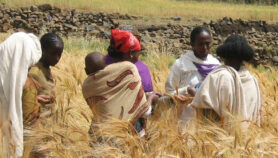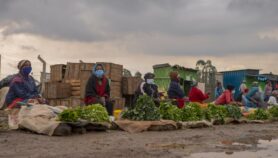By: Joris Tielens
Send to a friend
The details you provide on this page will not be used to send unsolicited email, and will not be sold to a 3rd party. See privacy policy.
[WAGENINGEN] Eating yellow cassava bred to be richer in beta-carotene increased the level of vitamin A in children’s blood by only a small amount, according to new results.
But some experts, including the scientist leading the trial, say there is potential for growing yellow cassava in Africa and parts of Asia to correct vitamin A deficiency — which leads to blindness and death in many thousands of children.
Elise Talsma conducted the randomised trial involving 342 children in rural Kenya as part of her PhD at Wageningen University, the Netherlands, and plans to submit the results to a peer-reviewed journal.
She measured both beta-carotene, a molecule that the body can turn into vitamin A, and vitamin A itself in blood samples of children who consumed 350 grams of cooked yellow cassava a day for four months, in 2012. Nearly a quarter (24 per cent) of the children had vitamin A deficiency, which is defined as having a vitamin A blood level lower than 0.7 micromoles per litre.
“The efficacy of biofortified cassava has been proved for the first time.”
Erick Boy, CIAT
Yellow cassava increased beta-carotene concentration in children’s blood by five times compared with a control group who ate traditional white cassava.
But the vitamin A concentrations improved on average only by 0.04 micromoles per litre — not enough to significantly reduce the number of children with vitamin A deficiency.
Despite the limited result, Talsma believes the effect is likely to increase when larger volumes are consumed for a longer period, and with better varieties that are currently being bred to double the current concentration of beta-carotene.
She says biofortification is needed to complement other approaches such as supplementation and fortification of food, which are not reaching enough people. In the district she worked in, existing supplementation reached only 31 per cent of children, according to a paper published this year in the Journal of Epidemiology and Global Health.
And Talsma found through laboratory tests that seven out of eight bottles of different brands of cooking oil bought in Kenya that claimed to be fortified with vitamin A did not contain any more vitamin A than conventional cooking oil.
Talsma previously reported that the majority of children and their caretakers in her survey in three Kenyan primary schools prefer the sweeter yellow cassava to white cassava, in a study she led that was published in PLOS One.
‘Major step’ for proof of concept
Erick Boy, nutrition manager at the HarvestPlus programme, a joint venture between the International Center for Tropical Agriculture (CIAT) and the International Food Policy Research Institute (IFPRI), welcomes the results.
“The efficacy of biofortified cassava has been proved for the first time,” he says. “Demonstrating a biologically important effect under strictly controlled conditions, as in this trial, is a major step towards proof of concept for biofortification of cassava with beta-carotene as a potential public nutrition alternative.”
Richard Sayre, who leads a group at the New Mexico Consortium that has researched high beta-carotene transgenic cassava, says the results are promising and consistent with previous studies on transgenic cassava.
But Marianne van Dorp, a food and nutrition specialist at the Wageningen University and Research centre, is more critical.
“It is good that the real potential of biofortification in terms of impact on human nutritional situation is assessed,” she says. “This research shows that the effect is modest, and that other complementary interventions are needed, such as supplementation, fortification and dietary diversification, especially if micronutrient deficiencies are deep.”
Link to thesis summary
Link to study abstract in Journal of Epidemiology and Global Health
Link to study in PLOS One about acceptability of yellow cassava














